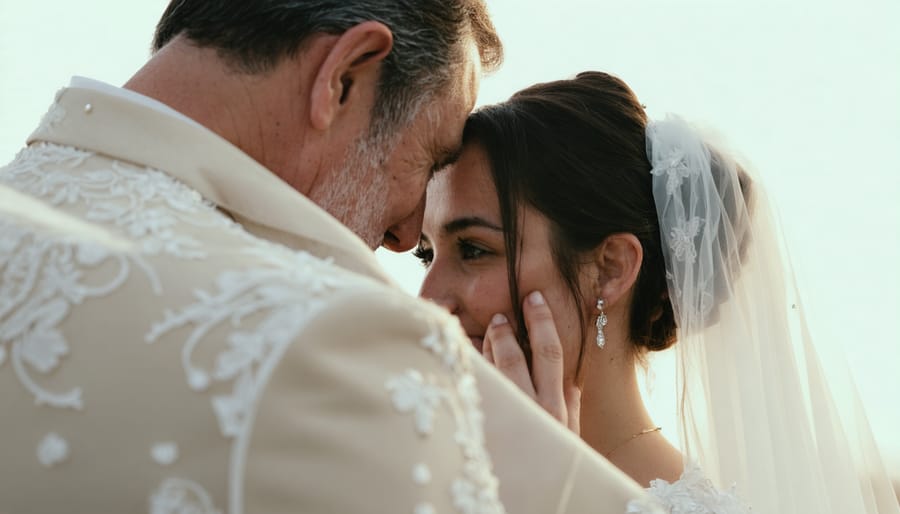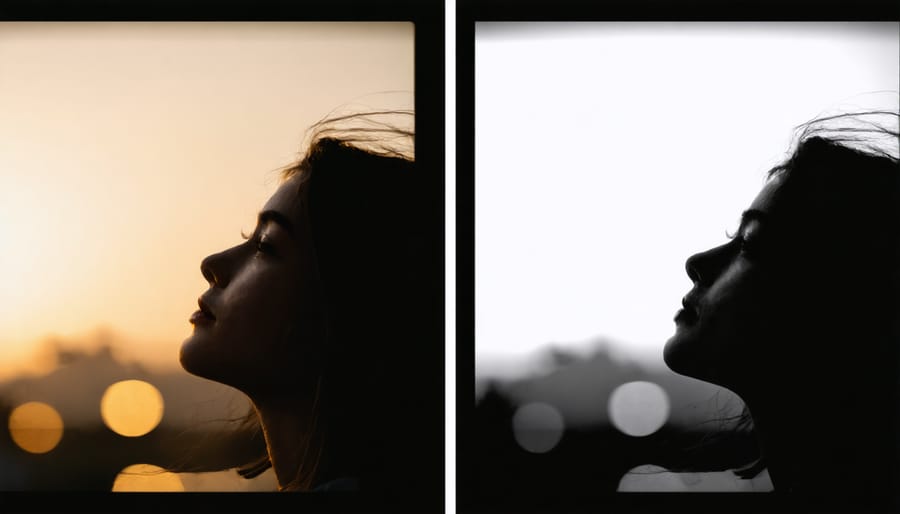
Raw emotion transforms ordinary photographs into powerful visual stories that resonate across time and cultures. Capturing genuine emotional moments demands a delicate balance between technical precision and respecting subject privacy, while maintaining an intuitive awareness of human connection.
Master anticipation by studying body language and facial micro-expressions – the slight curl of a smile before it blooms, the gathering tears before they fall, the tense shoulders before they relax in joy. Position yourself deliberately in emotion-rich zones: the parents’ view during a graduation, the quiet corner where wedding guests share intimate moments, or the sidelines where athletes process victory and defeat.
Work with available light to preserve authenticity, avoiding harsh flash that can startle subjects out of natural emotional states. Shoot in burst mode during pivotal moments, but remain present enough to recognize when lowering the camera creates space for genuine emotional display. The most moving photographs often emerge from this dance between technical readiness and human sensitivity.
This methodical yet empathetic approach transforms fleeting emotions into lasting visual narratives that speak to the core of human experience.
Reading the Room: Anticipating Emotional Moments
Key Moments Timeline
Every event has predictable emotional peaks that photographers can anticipate and prepare for. At weddings, key moments include the first look, exchange of vows, and first dance. Position yourself strategically 5-10 minutes before these moments to capture authentic reactions. For graduations, focus on the diploma handover and the moment students spot their families in the crowd.
During birthday celebrations, be ready when the candles are lit and the birthday song begins – genuine smiles and excitement peak during these traditions. At sports events, emotional highlights typically occur at game-changing moments and final scores, so stay alert to the game’s progress.
For corporate events, awards presentations and recognition speeches offer prime opportunities for capturing pride and accomplishment. Family reunions often have powerful emotional moments during initial greetings and group activities.
Remember that between these peak moments, candid interactions can yield equally moving photos. Keep your camera ready but discrete, allowing genuine emotions to unfold naturally while maintaining awareness of the event’s schedule and flow.
Body Language Signals
Understanding body language cues is essential for anticipating and capturing authentic emotional moments. Watch for subtle signals like hand gestures, posture changes, and physical proximity between subjects. When people lean towards each other, it often indicates intimacy or engagement, while crossed arms might suggest defensiveness or discomfort.
Pay special attention to micro-expressions – those fleeting facial movements that last just a fraction of a second. Look for crinkled eyes during genuine smiles, raised eyebrows during moments of surprise, or slight head tilts that show attention and connection between subjects.
During events, scan the room continuously for clusters of interaction. People’s feet often point towards what interests them most, making this a reliable indicator of where emotional moments might unfold. Watch for touch patterns too – a gentle hand on someone’s shoulder or an enthusiastic embrace can signal powerful emotional exchanges.
Remember that cultural differences can affect body language interpretation, so familiarize yourself with the specific customs and gestures of the event you’re photographing. Being attuned to these nonverbal cues helps you position yourself strategically and capture emotions at their peak.

Technical Settings for Emotional Impact
Aperture and Depth
Mastering depth of field through aperture control is crucial when capturing emotional moments. By strategically using shallow depth of field, you can isolate your subject from distracting backgrounds, drawing viewers directly to the emotional core of your image. While finding the optimal camera settings may take practice, the impact is worth the effort.
For intimate emotional portraits, consider working with wider apertures (f/1.4 to f/2.8) to create a dreamy, separated effect that emphasizes your subject’s expressions. This technique works particularly well for candid moments like a bride’s tears during vows or a child’s laughter at a family gathering. The soft, creamy background helps eliminate visual noise that might otherwise compete with the emotional impact.
However, when capturing group emotions or environmental context is important, stop down to f/5.6 or f/8. This allows you to maintain sharp focus across multiple subjects while still achieving some background separation. Think of a family’s collective joy during a reunion or the shared excitement of sports fans – these moments often benefit from greater depth of field to tell the complete emotional story.
Remember that depth of field isn’t just about technical settings; it’s a storytelling tool. Use it intentionally to guide your viewer’s eye and enhance the emotional resonance of your photographs.

Shutter Speed Choices
Shutter speed plays a crucial role in conveying emotion through your photographs, acting as a powerful tool for storytelling. When capturing dynamic motion, you have two main creative approaches: freezing the action or allowing intentional blur.
Fast shutter speeds (1/500th or higher) freeze moments in time, perfect for capturing sharp, crystal-clear expressions of joy, surprise, or excitement. Think of a bride’s tears during the first look or a child’s mid-air leap of excitement – these split-second emotional displays demand faster speeds to preserve their impact.
Slower shutter speeds (1/60th or lower) create motion blur, which can evoke different emotional responses. A slight blur in a couple’s first dance can suggest romance and fluidity, while intentional motion in a crowd scene can convey energy and excitement. This technique works particularly well when you want to emphasize the mood rather than the exact moment.
For emotional portraits, try experimenting with speeds between 1/125th and 1/250th. This range typically provides enough clarity for facial expressions while maintaining a natural feel. Remember that lighting conditions will influence your choices – you might need to adjust your ISO or aperture to maintain your desired shutter speed while ensuring proper exposure.
The key is matching your technical choices to the emotional message you want to convey. Practice these techniques in different scenarios to develop an instinct for which speeds best serve your creative vision.
Composition Strategies That Connect
Environmental Context
The environment surrounding your subject plays a crucial role in storytelling through emotional photography. A cluttered or distracting background can diminish the impact of even the most powerful emotional moments. Look for clean, complementary backgrounds that add context without competing for attention. Natural elements like texture, leading lines, and frames within the scene can enhance the emotional narrative.
Consider how different environments affect your subject’s comfort level and emotional state. A familiar setting, like someone’s home or favorite park, often yields more authentic expressions than a formal studio. Pay attention to lighting conditions in your chosen environment – soft, directional light can emphasize facial expressions, while harsh overhead lighting might create unflattering shadows that mask emotions.
Environmental elements can also serve as powerful metaphors. A solitary figure against a vast landscape can convey loneliness, while tight urban spaces might emphasize intimacy or claustrophobia. Weather conditions, seasonal changes, and time of day all contribute to the emotional atmosphere of your images.
When possible, scout locations beforehand to identify spots that offer both technical advantages and emotional resonance. Look for areas that provide multiple compositional opportunities while maintaining a connection to your subject’s emotional state.
Multiple Subject Dynamics
When photographing multiple subjects, the emotional dynamic between them often tells the most compelling story. Position yourself to capture the interaction between people, whether it’s a shared laugh between friends or an intimate moment between family members. Pay attention to physical connections – clasped hands, embraces, or even subtle gestures that reveal relationships.
Consider the rule of triangles when photographing three or more subjects, creating visual paths that lead viewers through the emotional narrative. Watch for mirrored expressions and reactions, as emotions often ripple through groups, creating powerful sequences of candid moments.
Distance plays a crucial role in emotional group shots. Sometimes, stepping back allows you to capture the entire emotional atmosphere, while moving closer highlights specific interactions. Look for contrasting emotions within the same frame – for instance, a crying child next to a comforting parent, or the mix of joy and tears at a wedding.
Body language speaks volumes in group dynamics. Notice how people naturally position themselves relative to others they’re comfortable with. These subtle cues – a slight lean toward someone, shared eye contact, or synchronized movements – can transform an ordinary group photo into an emotionally charged narrative that resonates with viewers.
Light and Shadow as Emotional Tools
Light and shadow are powerful storytelling elements that can dramatically influence the emotional impact of your photographs. When wielded thoughtfully, these tools can transform an ordinary scene into a compelling emotional narrative. Understanding dramatic lighting techniques is essential for photographers looking to enhance the mood of their images.
Natural light offers endless possibilities for emotional expression. Soft, diffused light filtering through windows can create a gentle, contemplative atmosphere perfect for intimate moments. Harsh directional light, on the other hand, can add drama and intensity to your shots, particularly when combined with deep shadows that create mystery and tension.
Consider the emotional associations of different lighting scenarios:
– Golden hour light creates warmth and nostalgia
– Blue hour adds a touch of melancholy or serenity
– Strong backlight can evoke hope or triumph
– Side lighting emphasizes texture and character
– Shadow play can suggest mystery or introspection
When working with artificial light, remember that direction and quality matter as much as intensity. A single off-camera flash positioned at eye level might flatten emotions, while the same light placed at an angle can sculpt features and enhance depth. Experiment with modifiers like softboxes for flattering portraits or bare bulbs for raw, authentic moments.
Don’t shy away from shadows – they’re equally important in emotional storytelling. Deep shadows can hide certain elements while highlighting others, directing viewers’ attention to the most emotionally significant parts of your frame. The interplay between light and shadow creates contrast that can mirror the emotional contrasts in your subject matter.
Remember to match your lighting choices to the emotion you’re trying to capture. Joyful moments often benefit from bright, even lighting, while more contemplative or serious emotions might be better served by moody, directional light. The key is to observe how different lighting conditions affect the emotional resonance of your images and adapt your approach accordingly.

Post-Processing for Emotional Impact
Post-processing plays a crucial role in amplifying emotional impact while maintaining the authenticity of your captured moments. The key is to enhance what’s already there without creating artificial emotions through heavy-handed editing.
Start by adjusting the overall tone of your image to match the emotional temperature. Warm tones can enhance feelings of joy, love, and celebration, while cooler tones might better suit moments of reflection or solemnity. Subtle shifts in temperature can make a significant difference in how viewers connect with the image.
Contrast adjustments can dramatically affect emotional weight. Higher contrast often intensifies drama and impact, while slightly reduced contrast can create a softer, more intimate feeling. When working with black and white conversions, pay special attention to tonal relationships that emphasize facial expressions and body language.
Vignetting, when applied subtly, can direct attention to emotional focal points without appearing artificial. Consider using radial filters to softly illuminate faces or gentle dodging and burning to guide the viewer’s eye to crucial emotional elements.
Color grading should support the emotional narrative. For instance, muting distracting colors in the background while preserving skin tones can help viewers focus on genuine emotional expressions. However, resist the temptation to over-saturate or apply trendy filters that might date your images or diminish their authenticity.
Remember that less is often more when processing emotional photographs. The goal is to enhance the natural emotional resonance while maintaining credibility. If viewers can detect your editing, you’ve likely gone too far. Let the genuine emotions speak for themselves, with your processing serving as a gentle amplifier rather than the main actor.
Capturing genuine emotions through photography is both an art and a skill that develops with dedication and practice. By combining technical expertise with emotional intelligence, you can create images that truly resonate with viewers and tell compelling stories. Remember to always respect your subjects’ boundaries while maintaining awareness of decisive moments that can unfold at any time.
The key to success lies in mastering the foundational techniques we’ve discussed: anticipating emotional peaks, understanding body language, and utilizing appropriate camera settings. However, equally important is developing your own intuition and style. Every photographer brings their unique perspective to emotional photography, and this personal touch is what makes your work distinctive.
Practice these techniques regularly, whether at family gatherings, street photography sessions, or professional events. Start with familiar environments where you feel comfortable, then gradually challenge yourself with more complex emotional scenarios. Keep a photography journal to track what works and what doesn’t, noting both technical details and emotional contexts.
Remember that not every attempt will result in a perfect capture – and that’s perfectly fine. The process of learning to photograph emotions is as much about personal growth as it is about technical improvement. Stay patient, remain observant, and always be ready for those fleeting moments when genuine emotions surface. With time and practice, you’ll develop an instinct for capturing the depth of human experience through your lens.























